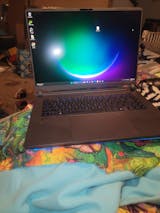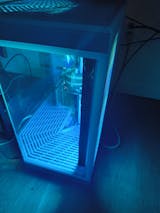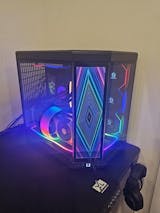Hardware for games changes very quickly, and 2025 looks like it will be no different. As it gets easier to get cutting-edge computers, next-generation graphics cards, and very fast interfaces, it's important to make plans ahead of time. Whether you're a serious gamer or just like to play for fun, making sure your system is ready for the future can save you money and hassle in the long run. Here are the most important things to think about to make sure your game rig will last until 2025.
1. Choose a High-Core-Count CPU
Why it matters: Games today use more than one thread, and next-gen games are likely to make that trend even stronger. Having a CPU that can do more than one thing is also important for streaming games, making content, and using AI-powered features in games.
What to look for:
- At least 8 to 12 cores: This baseline helps ensure enough headroom for new AAA titles.
- PCIe 5.0 (or newer) support: It’s critical that your motherboard/CPU combo supports the latest PCI Express standards for faster data transfers.
- Overclocking capability: Even if you don’t plan to overclock initially, having headroom can be beneficial a couple of years down the line.
2. Prioritize a Next-Gen GPU
Why it matters: The graphics card is what makes a game PC work. Newer GPUs have hardware-based ray tracing, AI-accelerated super-resolution, and a lot of VRAM to support 4K (and maybe even 8K) games.
What to look for:
- Ray-tracing performance: Ray tracing is common in movies with big budgets. Make sure that your GPU can handle a lot of frames per second.
- At least 16GB VRAM: More VRAM will be needed for future games, and 16GB is quickly becoming the best amount, even for 1440p. Having 24GB or more is helpful for high-end 4K games.
- AI acceleration:As upscaling and in-game features that use AI become more widespread, GPUs with AI hardware will last longer.
3. Embrace DDR5 (or Newer) Memory
Why it matters: The amount and speed of system RAM can slow things down. As game files get bigger, you'll need a lot of fast memory to run multiple programs and stream in the background.
What to look for:
- DDR5 with high speed and low latency: DDR5 modules can easily go over 6000 MT/s, which makes the whole machine run faster.
- At least 32GB: 16GB is still enough for many games, but 32GB or even 64GB gives you more room for future AAA games and running multiple programs at once.
4. Invest in Fast, Generous Storage
Why it matters: The amounts of game files keep getting bigger, and now they can be up to 100GB. Load times and stuttering are cut down by accessing big game assets more quickly.
What to look for:
- NVMe SSDs (PCIe 4.0/5.0): Choose at least one M.2 drive that can read at speeds of over 5000 MB/s to get the most out of new loading technologies.
- 2TB or more: When you have a lot of high-resolution image packs and games, space goes away quickly. Don't skimp on space.
5. Future-Proof Motherboard Features
Why it matters: The motherboard is what your machine is built on. New technologies can be added to a board that supports them without having to rebuild the whole system.
What to look for:
- PCIe 5.0 support: Ensures compatibility with next-gen GPUs and storage solutions.
- USB4 / Thunderbolt 4: High-speed USB/Thunderbolt connectivity is handy for external devices, VR headsets, and future accessories.
- Wi-Fi 7 or 6E: Future-proof your wireless connection for smooth online gaming.
6. Choose an Adequate Power Supply
Why it matters: High-end GPUs and CPUs these days can be power-hungry, and you don't want your PSU to stop you from upgrading or make your system unstable.
What to look for:
- 80 PLUS Gold or Platinum certification: Ensures efficiency and reliability.
- Sufficient wattage headroom: Aim for a PSU that offers 20–30% extra capacity above your system’s peak load. For many high-end builds, 850W to 1000W is a good target.
7. Master Your Cooling
Why it matters: Heat is the enemy of performance. As gear gets more powerful, good cooling keeps it running smoothly and extends the life of the parts.
What to look for:
- Liquid cooling (AIO or custom loop): Especially recommended for high-core-count CPUs and top-tier GPUs.
- Ample case airflow: Invest in quality fans with adjustable RPM and a case designed for optimized air intake/exhaust.
8. Keep an Eye on AI and Specialized Accelerators
Why it matters: As more games add AI-driven features, like generative content and how NPCs act, systems that can handle AI workloads will be in a clear benefit.
What to look for:
- AI co-processing: Some CPUs and GPUs now come with dedicated AI accelerators or neural engines.
- Driver and software ecosystem: Ensure your hardware vendors are known for frequent updates that incorporate new AI features.
9. Plan for Peripheral Upgrades
Why it matters: Even if you have the best PC in the world, slow or old tools can slow it down. Also, immersive technologies like AR, VR, and haptic gadgets will need strong backing.
What to look for:
- High-refresh monitors: 144Hz to 240Hz (or higher) displays are becoming common, especially for competitive gaming.
- VR/AR readiness: If you’re eyeing the VR revolution, ensure your motherboard and GPU can handle advanced headsets with minimal latency.
- Ergonomic and customizable peripherals: A reliable mechanical keyboard, high-precision mouse, and decent headset can significantly enhance gameplay.
10. Stay Flexible
Why it matters: Technology can surprise us even when we plan it well. Your rig will stay useful for longer if you leave room for small improvements.
What to look for:
- Spare expansion slots: Having extra PCIe, M.2, or RAM slots will make upgrades easier.
- Modular PSU: This makes cable management simpler and swapping components easier.
Preparing for the future doesn't mean you'll never have to improve, because technology changes all the time. But picking the right parts can help you stay in the game longer by giving you great graphics, stable performance, and room for the next big step forward in gaming technology. You'll be ready for anything 2025 throws at you if you pay attention to the CPU, GPU, memory, and system features and make sure you have enough power and cooling. If you choose the right gear, your rig will last for many years.















